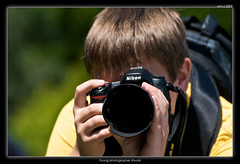Photography in the science classroom
By Mary Bigelow
Posted on 2011-11-23
 My school is offering “mini-grants” to teachers. It’s not a lot of money, but every little bit counts these days. I want to apply for funds for a digital camera for my elementary classroom. I know it would be useful, but the proposal requires a rationale and specific ideas for science use.
My school is offering “mini-grants” to teachers. It’s not a lot of money, but every little bit counts these days. I want to apply for funds for a digital camera for my elementary classroom. I know it would be useful, but the proposal requires a rationale and specific ideas for science use.
Jennifer, Evansville, Indiana
In the pre-digital age, cameras were a bit of a luxury in the classroom—there was the cost of the camera itself as well as the costs of purchasing film and developing and printing the pictures. Digital cameras have eliminated these additional expenses, and the photos are readily available to you and your students. You and your students can incorporate images into other digital and print resources, assuming you have the hardware and software in your classroom to download and edit photos or video and to print pictures. The technology keeps getting better and better.
Students love to take photographs, and many of them may already have their own cameras, including cell phone cameras. However, schools often do not allow students to use cell phones in the classroom, even for academic tasks, and it would be a challenge to collect the images from different phones and cameras for class projects. Teachers sometimes bring in their own equipment for the classroom, but it’s better to keep your personal things at home. (I learned this the hard way when one of my cameras “disappeared” from a locked desk drawer. The school insurance did not cover it, and I’m glad it was an inexpensive one.)
Science classes are great venues for photography. The students are actively learning concepts and skills, and science topics are interesting to illustrate. When students create visuals to communicate, they are developing skills in visual literacy. Some ideas include
- Student presentations
- Field trip activities
- Examples of science fair display boards
- Showing the steps of an investigation
- Illustrations for reports
- Photos for science notebooks
- Photos of lab set-ups
- Virtual albums with examples of simple machines, rock formations, insects, cloud formations, erosion, and more
- Mystery objects (such as the ones on the last page of Science Scope) for discussions or bell-ringers
- Photos of class activities for bulletin boards, instead of commercial posters or other decorations
- Special event “scrapbooks”
- “Good news” photos to send to parents—in print or electronically—showing the students engaged in science activities
- Photos of ongoing observations (e.g., a butterfly in the stages of metamorphosis, the location of the sun during the year, a class garden, crystal growth, plant growth)
- Illustrations of safety rules with students as models or student-created posters of safety rules
- Illustrations for student handouts or assessments
- Illustrations for vocabulary on a word wall
- Photos used with writing prompts
- Incorporate photos into presentations such as wikis, blogs, or Glogster
When you get the camera(s), ask the art teacher to help students learn the basics of photographic design. Establish class guidelines about the appropriate use and care of the cameras. In cooperative groups, one student could be assigned the role of photographer. He or she would be the one responsible for using the camera during the activity. If students are using the cameras in class, be sure they return them to you before you dismiss the class. Check the cameras periodically to delete any inappropriate photos.
Some students may not want to be photographed. Check with your school for any policies about photographing students (parental permission may be required) or posting pictures of students on public websites, including blogs, wikis, social media sites, and online photo galleries.
At an NSTA conference, I saw a technology demonstration that connected cameras and computers wirelessly. As soon as the picture was taken, it was sent to the computer. It was quite a time-saver. Your tech staff may have more information on camera and network compatibility and with this technology.
The NSTA journals have published articles on photography in science classrooms with many more ideas. I’ve assembled a collection of articles in the NSTA Learning Center.
Good luck with your proposal!
Disclaimer: The views expressed in this blog post are those of the author(s) and do not necessarily reflect the official position of the National Science Teaching Association (NSTA).


